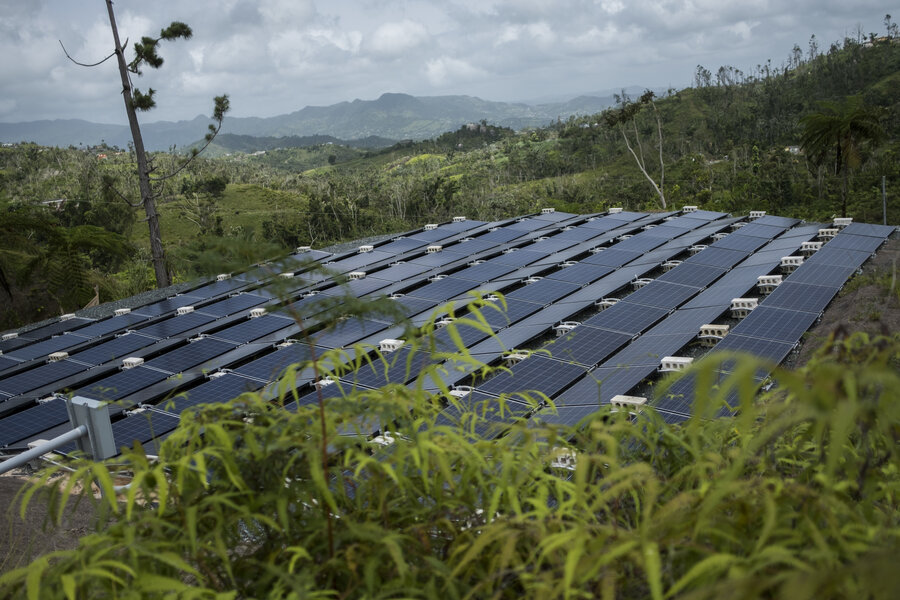Solar power to deliver unique benefits to war-prone and disaster areas
| London
Cheap, reliable, and hard to hijack, the sun could be an ideal energy source in many war zones and disaster areas, prompting aid agencies to consider ditching costly fuel for solar power.
While the technology has not advanced far enough to make a full swap viable, some solar projects are already underway in the field and aid workers expect many more to follow.
"It's very easy to exploit the fuel chain and it happens in a number of big emergencies. It's too easy to nick. There's a lot of bad practice around making money out of fuel," said Andy Bastable, head of Oxfam's water and sanitation projects.
Traditional fuel can be used as a weapon, hijacked by militants, sold on the black market, or must be flown vast distances to reach off-grid relief camps, increasing costs and volatility for the hard-pressed aid sector.
And the sun shines in most areas where they work.
"In 90 percent of cases, we are acting in places where there is abundant solar supply," said Per-Erik Eriksson, an engineer with medical charity Doctors Without Borders (MSF).
"To avoid logistical challenges and over time, to save costs, [solar energy] would certainly be a very good solution in most of our projects," he told the Thomson Reuters Foundation.
Renewable energy sources, such as solar power, are key to reducing climate-changing emissions and keeping the earth's temperature rise to 1.5 degrees Celsius.
A report this week by the United Nations Intergovernmental Panel on Climate Change said renewable energy would need to supply 70 to 85 percent of electricity by 2050 to stay within a 1.5 degree limit, compared with about 25 percent now.
Cost of fuel is volatile
For engineer Talal Kanaan, rolling out nearly 500 solar panels to power hospitals in war-battered Syria last year was the logical way to keep the country's health system running.
"We didn't want to put solar for the sake of it because it's 'cool' or environmentally friendly," said Mr. Kanaan, founder of Syria Solar, part of the Union of Medical Care and Relief Organizations (UOSSM), a coalition of medical groups.
"The role of solar was to increase the resilience of the health system," he said in a phone interview with the Thomson Reuters Foundation.
Syria's electrical grid has taken a big hit after seven years of war with infrastructure destroyed, leaving hospitals relying on diesel generators and at the mercy of fuel shortages.
"The costs and the availability of fuel is volatile. That's the problem: the source of it is coming from an area that is in conflict or across the firing line," said Kanaan.
He said fuel could easily be used as a weapon of war, referring to 2015 when Islamic State militants hijacked oil fields in northern Syria, which drove up diesel prices and paralyzed hospitals, ambulances, and rescue services.
In contrast, Syria Solar says if there was an outage, its solar system can fully power an intensive care unit, operating rooms, and emergency departments for up to 24 hours without diesel, which is 20 to 30 percent of the hospital's energy cost.
The group said it also saves about 7,000 liters of diesel per month and cuts about 200 tonnes of carbon each year.
Using grant money, Kanaan said he hopes to deploy electric ambulances next year, and remotely connect people in Syria with overseas doctors through online services like Skype, which would be powered by the existing solar energy system.
Solar solution?
Mr. Eriksson said there was a dire need to use solar in emergencies, especially in rural areas that are not connected to the grid. Eriksson, who has worked in remote parts of the Democratic Republic of Congo on renewable energy projects, said delivering fuel was often the hardest and most expensive part.
"In some projects, we even fly in fuel and that's really tough and costly. But it's been the only alternative and that's why we do it," he said in a phone interview.
Many aid groups told the Thomson Reuters Foundation they already run some solar energy projects, but admit that a complete switch to cleaner energy could take years.
Humanitarian agencies still largely depend on diesel generators, said Alain Oppliger, a sustainable development adviser at the International Committee of the Red Cross (ICRC).
"Renewable energy sources such as solar panels take time to be installed. When you require energy immediately in an emergency, then fuel-powered generators are still the best option," said Mr. Oppliger in emailed comments.
Many locals in the community already know how to use traditional fuel-powered generators, but implementing solar energy would need specialized knowledge, aid agencies said.
Battery technology: the final frontier
But one of the biggest hurdles is storing excess renewable energy in large enough batteries, several aid agencies said.
"Battery technology hasn't moved much at all – it's the final frontier," said Mr. Bastable of Oxfam. "If they can come up with some kind of innovation around how to store the energy better, then renewables become a lot more attractive."
Batteries have long held the promise of solving the intermittent nature of renewables such as wind and solar.
Pairing big batteries with renewable energy boosts reliability without creating carbon emissions, and more homes and businesses are looking to batteries for backup power and to capture excess energy to use when the sun is not shining.
Eriksson was confident technology would trickle down.
"Prices [for solar technology] are coming down quite rapidly but it's still a few years away, which is why it might be more difficult in the emergency context," said Eriksson. "But I really strongly believe that we will see a stronger movement [towards renewable energy] over the coming, say, five years."
This story was reported by the Thomson Reuters Foundation.








